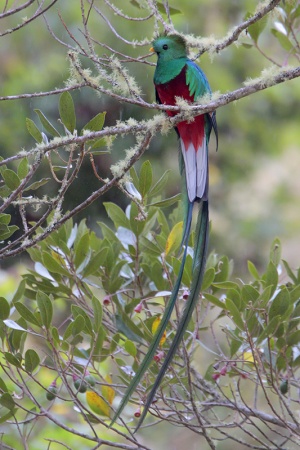m |
m |
||
| Line 14: | Line 14: | ||
Montane forests. | Montane forests. | ||
[[Image:d10_1078.jpg|thumb|300px|right|'''Female'''. Photo by {{user|Gary+Clark|Gary Clark}} <br/>Location: Dota Valley, [[Costa Rica]].]] | [[Image:d10_1078.jpg|thumb|300px|right|'''Female'''. Photo by {{user|Gary+Clark|Gary Clark}} <br/>Location: Dota Valley, [[Costa Rica]].]] | ||
| − | [[Image:Resplendent_Quetzal_Lavaty.jpg|thumb|300px|right|'''Male'''. Photo by {{user|Peacefrog2|Greg Lavaty}} <br />[[Costa Rica]], January 2009]] | + | [[Image:Resplendent_Quetzal_Lavaty.jpg|thumb|300px|right|'''Male'''. Photo by {{user|Peacefrog2|Greg Lavaty}} <br />[[Monteverde]], [[Costa Rica]], January 2009]] |
==Behaviour== | ==Behaviour== | ||
The diet includes fruit and insects, notably wasps, ants, and larvae, and frogs. Particularly important are wild avocados and other fruit of the laurel family, which the birds swallow whole before regurgitating the pits, which helps to disperse these trees. Some of these can be seen in the image of a female. These birds sometimes hover while they take the fruit. | The diet includes fruit and insects, notably wasps, ants, and larvae, and frogs. Particularly important are wild avocados and other fruit of the laurel family, which the birds swallow whole before regurgitating the pits, which helps to disperse these trees. Some of these can be seen in the image of a female. These birds sometimes hover while they take the fruit. | ||
Revision as of 14:04, 9 October 2010
- Pharomachrus mocinno
Identification
36 cm. Male: green body, showing iridescence from green-gold to blue-violet, red breast, green upper tail coverts, helmet-like crest. The mature male's beak is yellow and the female's is black. She additionally has red limited to the vent area, the breast is grayish-brown. Her tail shows uneven spacing of black barring on the underside, his is pure white. The juvenile male can easily be mistaken for a female; look for developing red plumage on the breast to distinguish it.
Distribution
Southern Mexico to western Panama, Nicaragua, where it is the national bird, and Costa Rica.
Taxonomy
Two subspecies: nominate mocinno is found from Mexico to Nicaragua, while costaricensis is in Costa Rica and Panama.
Habitat
Montane forests.
Behaviour
The diet includes fruit and insects, notably wasps, ants, and larvae, and frogs. Particularly important are wild avocados and other fruit of the laurel family, which the birds swallow whole before regurgitating the pits, which helps to disperse these trees. Some of these can be seen in the image of a female. These birds sometimes hover while they take the fruit.
The nest is placed in a hole, carved in a rotten tree and 2 pale blue eggs are laid. Both parents incubate for 18 days, during which the male generally incubates the eggs during the day while the female incubates them at night. When the eggs hatch, both parents take care of the young, feeding them fruit, berries, insects, lizards, and small frogs. The female can neglect or abandon the young near the end of the rearing period, leaving it up to the male to continue caring for the offspring until they are ready to survive on their own.






